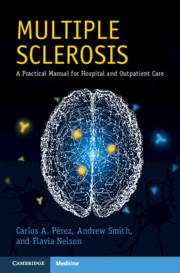Book contents
- Multiple Sclerosis
- Multiple Sclerosis
- Copyright page
- Contents
- Preface
- Chapter 1 Autoimmune CNS Emergencies
- Chapter 2 Clinical Features of Multiple Sclerosis
- Chapter 3 Multiple Sclerosis Phenotypes
- Chapter 4 Diagnostic Evaluation
- Chapter 5 Differential Diagnosis
- Chapter 6 Neuroimaging in Multiple Sclerosis and Its Mimics
- Chapter 7 Disease-Modifying Therapies
- Chapter 8 Treatment Goals
- Chapter 9 Symptomatic Management
- Chapter 10 Reproductive Issues
- Chapter 11 Pediatric Multiple Sclerosis
- Chapter 12 Useful Websites
- Appendices
- Index
- Plate Section (PDF Only)
- References
Chapter 7 - Disease-Modifying Therapies
Published online by Cambridge University Press: 10 February 2021
- Multiple Sclerosis
- Multiple Sclerosis
- Copyright page
- Contents
- Preface
- Chapter 1 Autoimmune CNS Emergencies
- Chapter 2 Clinical Features of Multiple Sclerosis
- Chapter 3 Multiple Sclerosis Phenotypes
- Chapter 4 Diagnostic Evaluation
- Chapter 5 Differential Diagnosis
- Chapter 6 Neuroimaging in Multiple Sclerosis and Its Mimics
- Chapter 7 Disease-Modifying Therapies
- Chapter 8 Treatment Goals
- Chapter 9 Symptomatic Management
- Chapter 10 Reproductive Issues
- Chapter 11 Pediatric Multiple Sclerosis
- Chapter 12 Useful Websites
- Appendices
- Index
- Plate Section (PDF Only)
- References
Summary
With the ongoing expansion of the therapeutic armamentarium, treatment strategies for multiple sclerosis (MS) have undergone profound changes in the last few years. Several treatment options are available at this time, and the effects of these drugs appear to be greater when treatment is initiated early, soon after the onset of symptoms. This chapter reviews currently used disease-modifying agents (Figure 7.1) in addition to several promising therapies in various phases of development.
- Type
- Chapter
- Information
- Multiple SclerosisA Practical Manual for Hospital and Outpatient Care, pp. 121 - 144Publisher: Cambridge University PressPrint publication year: 2021



